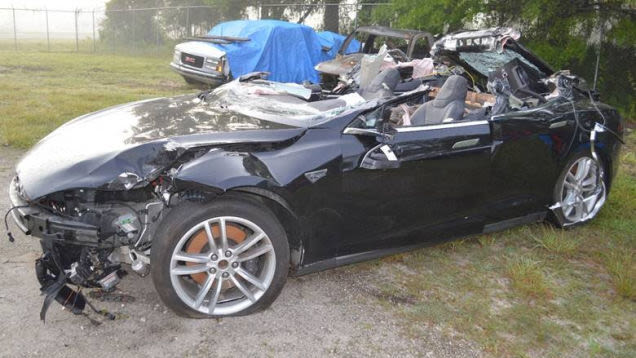The first fatal crash of an autonomous car and semi-truck in the United States occurred on May 7, 2016, in Williston, Florida. A semi-truck was making a left turn from westbound US-27A across the two eastbound travel lanes onto NE 140th Court. The car, a Tesla Model S 70D sedan operating in Autopilot mode, was driven by 40 year-old Joshua Brown of Canton, Ohio. His car struck the right side of the semi-trailer crossed underneath it and then went off the right roadside. The impact of the semi-trailer sheared off the roof of the car.

Florida Highway Patrol: Tesla Crash Image
The driver, the sole occupant of the car, died in the crash. The commercial truck driver was not injured. System performance data downloaded from the car indicated that the driver was operating the Traffic-Aware Cruise Control and Auto-Steer Lane-Keeping Systems, which are automated vehicle control systems within Tesla’s Autopilot suite.
The National Transportation Safety Board (NTSB) has ruled that the truck driver’s “failure to yield the right of way” and the car driver’s “inattention due to over-reliance on vehicle automation” were the probable cause of the May 7 collision. In a statement on the report, which was issued on Sept. 12, 2017, the NTSB said it also found that the operational design of the Tesla’s vehicle automation “permitted the car driver’s over reliance on the automation" noting its design "allowed prolonged disengagement from the driving task and enabled the driver to use it in ways inconsistent with manufacturer guidance and warnings.”
According to the NTSB report, the driver had been using Autopilot for 37 minutes, out of which he had placed his hands on the wheel for a total of just 25 seconds. This, despite seven separate visual warnings from the system, which flashed the message: “Hands required not detected.” Clearly the driver was determined to use Autopilot as if it were a fully autonomous driving system, rather than the safety mechanism that Tesla says it is meant to be. The NTSB report says he had set the software to a cruising speed of 74 mph, in a posted 65 mph zone shortly before the crash. The car was apparently still going that speed when it hit the truck’s trailer broadside.
Although the results of post-crash drug testing established that the truck driver had used marijuana before the crash, his level of impairment, if any, at the time of the crash could not be determined from the available evidence. Nothing was ever said about the truck driver being sited or at fault for anything other than “failure to yield right of way”.
No matter how automobiles or semi-trucks are designed, man will attempt to take them to their limit. It is human nature to put everything to the ultimate test. This collision proves that if we use autonomous autos and semi-trucks in the future of highway driving something in the system will fail “the driver”. The Tesla's Autopilot system did not have the ability to interpret the semi-truck's intentions. The semi-truck driver never considered the fact the car's driver was not actually driving or paying attention. The semi-truck driver assumed the car's driver was going to change lanes or slow down to prevent the collision. How do we, as humans know if someone is actually driving a vehicle or if it's autonomous?
This collision was a sobering reminder that autonomous driving software, for all its impressive achievements, remains far from perfect. Tesla’s Autopilot may save more lives than it cost lives, but there are still circumstances in which it is prone to error in ways that an attentive human driver never would be.
Smart people around the world are hard at work to automate driving, but systems available to consumers today, like Tesla’s ‘Autopilot’ system, are designed to assist drivers with specific tasks in limited environments. These systems require the driver to pay attention all the time and to be able to take over immediately when something goes wrong. These systems were never intended to replace all the driver function's when it comes to operating a vehicle. In this collision the car's driver never steered, braked, or evidently never even looked up.
I started driving truck at age 16 for my father. We had a redi-mix company in Tucson, AZ., and I was the chief sand and gravel hauler. Since then I have driven semi-trucks in many different environments, to include oil field, over the road, hazardous materials, and local driving, for construction companies. I have driven in the most adverse conditions in Wyoming and North Dakota during the winter months when the DRIVER must do his or her best to keep their semi-truck on the highway because of foul weather driving conditions, and other semi-truck drivers that are not experienced in winter driving conditions. If autonomous semi-trucks can be designed to chain up tires for adverse road conditions, or make the decision of what speed to travel depending on the snow, ice, and incompetent drivers on the roadway; then I may think about trying one.

